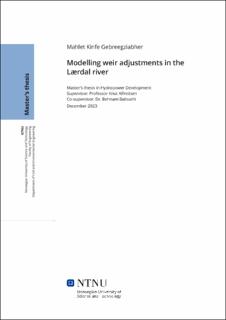| dc.description.abstract | In the context of regulated river management, weirs have historically been employed to counteract the consequences of reduced water flow resulting from river regulation interventions. The Laerdal River in western Norway, initially developed for hydropower in 1974, saw the construction of multiple weirs to fulfill diverse objectives, encompassing the maintenance of water levels, prevention of ice erosion, and the creation of a conducive habitat for Atlantic salmon. However, contemporary environmental awareness has sparked ongoing efforts to reassess the viability of these weirs, exploring potential removal or modification to further enhance the habitat for Atlantic salmon.
This thesis embarks on an exploration of weir modification methods, utilizing numerical modeling through Hec-Ras 2D to assess proposed alterations. Initial stages involve the preparation of 1.2 km geometry for selected four weirs in Lærdal, followed by the establishment of Hec-Ras 2D simulations calibrated against observed water levels. Subsequently, the focus shifts to the selection of a modification method aimed at improving conditions for Atlantic salmon and sea trout. This encompasses various strategies, including creating openings, replacing the weir with distributed rocks, and other innovative solutions.
Upon determining the modification method, the geometry is recalibrated with the new weir solution. Simulations encompassing different discharges yield results showcased through maps and graphs, revealing the impact of modifications on flow patterns and key hydraulic variables such as depth, velocity, and bed changes. Expanding the study to simulate high flows, the research estimates potential erosion and deposition around the modified weirs. The overarching goal of this thesis is to adapt the weir to enhance fish migration, whether focusing solely on improving fish migration or concurrently enhancing fish migration and mitigating sediment accumulation in the weir pool located upstream of the Øye.
The research findings inform an exploration into the significance of weir removal, particularly concerning the removal of fine sediments in the upstream portion of the pool at Øye. This investigation is integral for comprehending the potential impact of weir removal on sediment transport dynamics. Simultaneously, the study addresses the necessity for erosion protection measures and endeavors to determine the optimal stone size for securing the new structure. These considerations are crucial for crafting a recirculating, ecologically favorable habitat for Atlantic salmon, striking the right balance between depths and velocities among the rocks. Ultimately, this research aims to contribute valuable insights to the ongoing dialogue surrounding sustainable weir modifications and the coexistence of hydropower development with ecological preservation. | |
